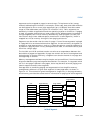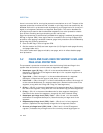
Vol. 3 4-53
PAGING
segments can be mapped to pages in several ways. To implement a flat (unseg-
mented) addressing environment, for example, all the code, data, and stack modules
can be mapped to one or more large segments (up to 4-GBytes) that share same
range of linear addresses (see Figure 3-2 in Section 3.2.2). Here, segments are
essentially invisible to applications and the operating-system or executive. If paging
is used, the paging mechanism can map a single linear-address space (contained in
a single segment) into virtual memory. Alternatively, each program (or task) can
have its own large linear-address space (contained in its own segment), which is
mapped into virtual memory through its own paging structures.
Segments can be smaller than the size of a page. If one of these segments is placed
in a page which is not shared with another segment, the extra memory is wasted. For
example, a small data structure, such as a 1-Byte semaphore, occupies 4 KBytes if it
is placed in a page by itself. If many semaphores are used, it is more efficient to pack
them into a single page.
The Intel-64 and IA-32 architectures do not enforce correspondence between the
boundaries of pages and segments. A page can contain the end of one segment and
the beginning of another. Similarly, a segment can contain the end of one page and
the beginning of another.
Memory-management software may be simpler and more efficient if it enforces some
alignment between page and segment boundaries. For example, if a segment which
can fit in one page is placed in two pages, there may be twice as much paging over-
head to support access to that segment.
One approach to combining paging and segmentation that simplifies memory-
management software is to give each segment its own page table, as shown in
Figure 4-12. This convention gives the segment a single entry in the page directory,
and this entry provides the access control information for paging the entire segment.
Figure 4-12. Memory Management Convention That Assigns a Page Table
to Each Segment
Seg. Descript.
LDT
Seg. Descript.
PDE
Page Directory
PDE
PTE
PTE
PTE
PTE
PTE
Page Tables
Page Frames


















